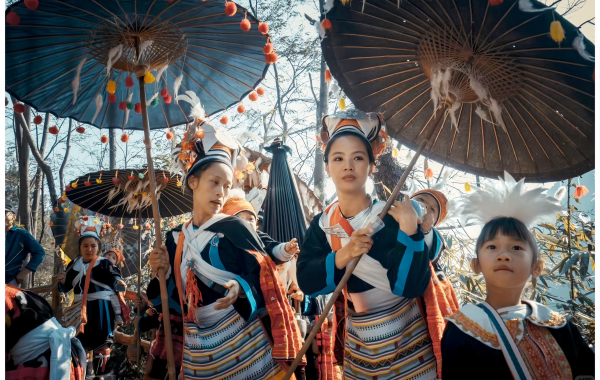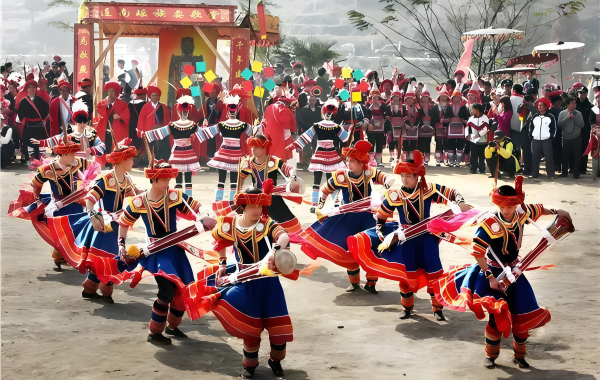Yao
Introduction

The Yao Nationality is a large and culturally diverse ethnic group in China. Known for their unique traditional costumes, rich folk customs, and long - standing cultural heritage, the Yao people have a close relationship with the mountainous and forested regions where they live. Their way of life has been shaped by the natural environment over centuries, resulting in a distinct cultural identity.
 History
History
· Origin
The Yao people are believed to have originated from ancient tribes in southern China. Over time, they gradually migrated and settled in the mountainous areas of southern China. Their early history is closely related to the development of agriculture and hunting in these regions, and they formed their own unique cultural characteristics through long - term interactions with the natural environment and neighboring ethnic groups.
· Development
During different historical periods, the Yao people had various forms of social organization and economic activities. In ancient times, they mainly engaged in slash - and - burn agriculture, hunting, and gathering. With the development of society, they gradually transitioned to more stable forms of agriculture, such as paddy farming and terraced field cultivation. Throughout history, the Yao people have maintained relatively independent cultural traditions while also having cultural exchanges with the Han and other ethnic groups.
· Modern Times
In modern times, the Yao people have actively participated in the construction and development of the country. With the improvement of transportation and communication, their living conditions have gradually improved. At the same time, they have made great efforts to preserve and inherit their traditional culture, such as through the establishment of cultural museums, the promotion of traditional festivals, and the protection of intangible cultural heritage.
 Population
Population
· Quantity
As of the latest census data, the Yao population in China is approximately 3.3 million, making it one of the larger ethnic minorities in the country.
· Distribution
The Yao people are widely distributed in southern China, with a relatively concentrated population in Guangxi Zhuang Autonomous Region. Their mountainous and forested habitats have not only influenced their economic activities but also contributed to the diversity and uniqueness of their culture. The geographical isolation in some areas has helped preserve certain traditional customs and languages.
 Economy
Economy
Traditionally, the Yao economy was based on agriculture, with a focus on terraced field cultivation of rice, corn, and sweet potatoes. Hunting and gathering also played a supplementary role in their livelihood. In addition, the Yao people were skilled in handicrafts, such as weaving, embroidery, and silver - making. In modern times, with the development of the market economy, many Yao people have engaged in forestry, animal husbandry, and tourism - related industries. Some areas have developed characteristic agricultural products, such as organic tea and fruits, which have brought economic benefits to the local Yao communities.
 Culture
Culture
· Language and Script
The Yao language belongs to the Miao - Yao branch of the Sino - Tibetan language family. There are several dialects among different Yao subgroups. Due to long - term contact with the Han people, many Yao people can also speak Chinese. In the past, the Yao language had no widely used written script. In modern times, some attempts have been made to create a written form based on the Latin alphabet to facilitate cultural transmission and education.
· Religious Beliefs
Polytheism is an important part of Yao religious beliefs. They worship natural gods such as the mountain god, river god, and tree god, believing that these gods control the natural forces and human destiny. Ancestor worship is also deeply rooted in Yao culture, and they hold regular ceremonies to pay respects to their ancestors. Additionally, Taoism and Buddhism have had some influence on the Yao people, and some elements of these religions can be seen in their religious practices and rituals.
· Clothing
Traditional Yao clothing is colorful and distinctive, often featuring intricate embroidery and silver ornaments. Women's clothing varies among different subgroups. Some wear long - sleeved jackets with colorful collars and cuffs, paired with pleated skirts. They also wear elaborate headpieces made of silver, feathers, and colorful threads. Men's clothing is relatively simple, usually consisting of short - sleeved or long - sleeved shirts and trousers, often with some decorative patterns.
· Agriculture
Agriculture has been the cornerstone of Yao culture and economy for a long time. The Yao people have developed advanced techniques for terraced field cultivation, which not only helps prevent soil erosion but also maximizes land use in mountainous areas. They have a deep understanding of the local climate and soil conditions and can grow a variety of crops according to the seasons. Agriculture is not only a means of subsistence but also an important part of their cultural heritage, reflected in their traditional festivals and folk songs related to farming.
· Literature
Yao literature is rich and diverse, including folk tales, legends, epics, and songs. These oral literary works have been passed down through generations, telling stories about the origin of the Yao people, their heroes, and their relationships with nature. Many of these stories reflect the Yao people's values, moral concepts, and historical experiences. In recent years, efforts have been made to collect, translate, and publish Yao oral literature to preserve and promote this valuable cultural resource.
· Transportation
In the past, due to the mountainous terrain, the Yao people mainly relied on foot for transportation. In some areas, they used horses or mules to carry goods. With the development of modern infrastructure, roads have been built in many Yao - inhabited areas, and motorcycles and cars have become common means of transportation. However, in some remote mountainous villages, traditional methods of transportation are still used for short - distance travel.
 Science
Science
· Medicine
Traditional Yao medicine has a long history and is based on the use of local herbs and plants. Yao healers have extensive knowledge of the medicinal properties of various plants and have developed unique formulas and treatment methods. They use herbal decoctions, ointments, and massages to treat a wide range of diseases. In recent years, there has been growing interest in studying and integrating traditional Yao medicine with modern medical science to explore its potential in healthcare.
· Calendar
The Yao people have their own traditional calendar, which is closely related to agricultural activities and natural phenomena. This calendar helps them determine the best time for planting, harvesting, and other farming operations. It also marks important cultural festivals and ceremonies throughout the year. Although the modern Gregorian calendar is widely used in daily life, the traditional Yao calendar still plays an important role in their cultural traditions.
 Art
Art
· Music
Yao music is characterized by its melodious melodies and rich rhythms. Traditional Yao musical instruments include the lusheng (a reed - pipe wind instrument), the suona (a double - reed horn), and various types of drums. Yao songs often express emotions such as love, joy, and sadness, and they also tell stories about daily life, history, and legends. Music plays an important role in Yao festivals, ceremonies, and social gatherings.
 · Dance
· Dance
Yao dance is lively and expressive, with movements that reflect the characteristics of mountain life and the Yao people's spiritual beliefs. There are various types of Yao dances, such as the long - drum dance, the bronze - drum dance, and the farming dance. These dances are often performed during festivals and important events, bringing people together and creating a joyful atmosphere.
· Architecture
Traditional Yao architecture is adapted to the mountainous environment. Yao houses are usually built on stilts or slopes to prevent moisture and floods. The materials used for construction are mainly wood and bamboo, which are readily available in the local area. The interior of the house is divided into different functional areas, such as living rooms, bedrooms, and kitchens. Some Yao houses also have unique decorative elements, such as carved wooden windows and doors, reflecting the Yao people's aesthetic taste.
· Landscape
The Yao - inhabited areas are often characterized by beautiful natural landscapes, including mountains, forests, rivers, and waterfalls. These natural sceneries have not only provided a livable environment for the Yao people but also inspired their artistic creation. Many Yao poems, paintings, and songs are inspired by the beauty of the local landscape, showing their deep love and appreciation for nature.
· Arts and Crafts
Yao arts and crafts are renowned for their exquisite craftsmanship and unique styles. Traditional Yao crafts include embroidery, silver - making, wood - carving, and bamboo - weaving. Yao embroidery is particularly famous for its colorful threads and intricate patterns, which often depict flowers, birds, and animals. Silver ornaments are also an important part of Yao traditional costumes, symbolizing wealth and beauty. These handicrafts are not only practical items but also valuable cultural artifacts that showcase the Yao people's artistic talents.
 Custom
Custom
· Etiquette
Yao etiquette emphasizes respect for elders and guests. When meeting elders or important guests, young people usually bow or nod as a sign of respect. In social interactions, politeness and modesty are highly valued. When visiting a Yao home, guests are often treated with great hospitality, and they are expected to follow certain customs, such as taking off their shoes before entering the house.
· Marriage Customs
Yao marriage customs vary among different subgroups but generally involve several stages, including courtship, engagement, and the wedding ceremony. In some areas, the "singing to find a lover" tradition is still practiced, where young men and women express their love through songs. The wedding ceremony is a grand event, often lasting for several days, with various rituals and activities, such as offering sacrifices to ancestors, exchanging gifts, and holding feasts.
· Festivals
The Yao people celebrate many important festivals throughout the year. The Pan Wang Festival is one of the most significant festivals, which is held to commemorate the ancestors of the Yao people. During this festival, people offer sacrifices, sing and dance, and hold various traditional activities. Other festivals include the Dragon Boat Festival, the Mid - Autumn Festival, and the Spring Festival, which are celebrated in a unique Yao style with special food, decorations, and performances.
· Diet
Yao cuisine is diverse and reflects the local agricultural products and cultural traditions. Sticky rice is a staple food in many Yao areas, and it is often used to make various dishes, such as glutinous rice cakes and rice dumplings. Yao people also like to eat meat, especially pork, and they have unique ways of cooking, such as smoking and stewing. In addition, they consume a variety of wild vegetables and herbs, which are rich in nutrients.
· Funeral Customs
Yao funeral customs are based on the belief in an afterlife and respect for the deceased. The funeral ceremony is usually solemn and elaborate, involving various rituals such as bathing the body, dressing it in new clothes, and offering sacrifices. Family and friends gather to mourn the deceased, and a feast is held after the funeral. The specific funeral customs may vary among different Yao subgroups, but they all reflect the Yao people's attitudes towards life and death.
What Our Clients Say?
Based on 10,000+ traveler reviews











